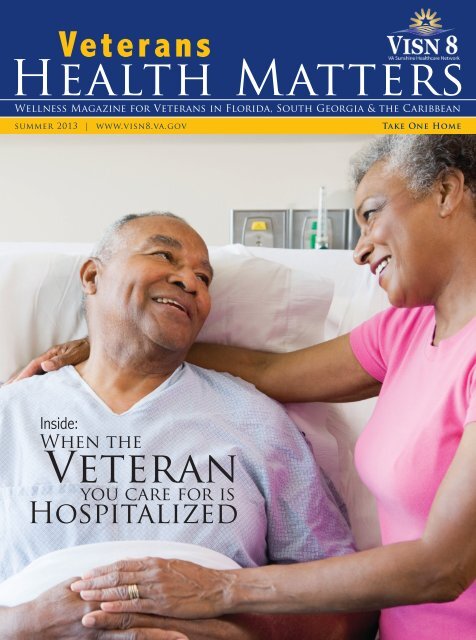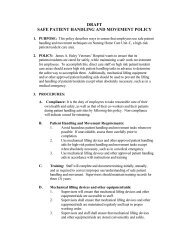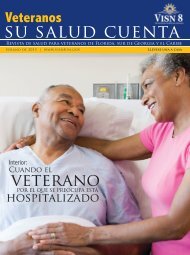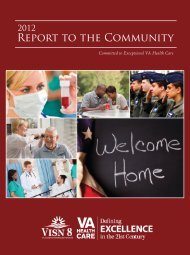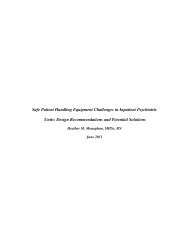English Version - VISN 8
English Version - VISN 8
English Version - VISN 8
Create successful ePaper yourself
Turn your PDF publications into a flip-book with our unique Google optimized e-Paper software.
Veterans<br />
Health Matters<br />
Wellness Magazine for Veterans in Florida, South Georgia & the Caribbean<br />
summer 2013 | www.visn8.va.gov<br />
Take One Home<br />
Inside:<br />
When the<br />
Veteran<br />
you care for is<br />
Hospitalized
COMING<br />
SOON<br />
to a VA Hospital Near You!<br />
To Our Readers<br />
If you aren’t strutting a healthier body<br />
thanks to the VA’s “Be Active and<br />
MOVE!” program, now is your chance.<br />
A successful new program at the VA<br />
hospital in Tampa uses the latest<br />
telehealth technology to motivate and<br />
educate people about exercise. On<br />
page 3, read about the pilot program<br />
and how it’s being extended to<br />
VA facilities throughout the VA<br />
Sunshine Healthcare Network.<br />
VA Caregiver Support is a focus in this issue of Health Matters.<br />
If you’re caring for the Veteran, you’ll want to know the proper<br />
legal documents to have in place before a medical crisis page 4.<br />
Page 5 offers steps on how to be a vital, respected member of<br />
your loved one’s Health Care Team. All of these preparations build<br />
confidence, ease stress, and ensure everything is in place for the<br />
very best care of your Veteran.<br />
Page 6 offers great tips on how Veterans can get the best overall<br />
care during emergencies that may require immediate treatment<br />
outside the VA medical system.<br />
Pay attention to the “Salty Six,” page 7, a list of the top foods<br />
in today’s diet that are loaded with excess sodium, putting you<br />
at risk of heart disease and stroke. For a salt-free alternative, try<br />
Veteran Terri Eanes’ cucumber salad recipe on that same page.<br />
The Interactive Patient Care<br />
•<br />
•<br />
•<br />
•<br />
•<br />
Learn about your health<br />
Communicate with hospital staff<br />
Surf the web<br />
Play games<br />
Watch your favorite TV shows & movies<br />
All for FREE. <br />
Customized just for YOU!<br />
Engaging Veterans to meet their<br />
individual health care needs.<br />
Help spread the word about the VA’s new E-Donate online option<br />
(back cover) that gives community members the opportunity to<br />
support a Veteran at a VA hospital quickly, easily and safely.<br />
Finally, this is my final column as I am retiring from the VA after<br />
34 years of federal service. I thank you for your service and your<br />
support. It has been my honor and privilege to serve you.<br />
Have a healthy and safe summer.<br />
Nevin M. Weaver, FACHE<br />
<strong>VISN</strong> 8 Network Director<br />
Managing Editor<br />
Susan Wentzell<br />
Editorial Board<br />
Mary Kay Hollingsworth<br />
<strong>VISN</strong> 8 Communication Manager<br />
Susan Wentzell<br />
<strong>VISN</strong> 8 Deputy Communication Manager<br />
Jason Dangel<br />
Public Affairs Officer, Bay Pines VAHCS<br />
Michelle Winslow<br />
<strong>VISN</strong> 8 Program Manager, Health Promotion<br />
& Disease Prevention (HPDP), and Co-Chair,<br />
<strong>VISN</strong> 8 Preventive Care Committee<br />
Diana Akins<br />
Bay Pines VA Healthcare System (VAHCS)<br />
Acting Veterans Health Education<br />
Coordinator & Co-Chair, <strong>VISN</strong> 8 Veterans<br />
Health Coordinators Workgroup<br />
Charlene Molloy<br />
ARNP, HPDP Program Manager,<br />
North Florida/South Georgia<br />
Veterans Health System (NF/SGVHS)<br />
Heather Frebe<br />
Public Affairs Officer, NF/SGVHS<br />
Maureen Cortese<br />
HPDP Program Manager,<br />
Orlando VA Medical Center<br />
Shane Suzuki<br />
Public Affairs Officer, Miami VAHS<br />
David P. Folds, III<br />
HPDP Program Manager,<br />
James A. Haley Veterans’ Hospital<br />
2 Veterans health matters » www.visn8.va.gov
TELEHEALTH<br />
Pilot Program Helps Veterans<br />
Once MOVE! Program Coordinator Melody Chavez initiated<br />
the “Be Active and MOVE!” pilot program for Veterans at the<br />
James A. Haley Veterans Hospital, it didn’t take long for her<br />
to see the program’s impact. “Many Veterans are joining in,<br />
getting into it, and talking it up. It’s been a great example<br />
of how we in VA are making prevention more engaging for<br />
Veterans, and using the latest telehealth technology to do it.”<br />
The Tampa-based hospital is one of several VA hospitals<br />
nationwide participating in the pilot program to extend the<br />
reach of planned physical activity programs for Veterans.<br />
Florida VA hospitals in Tampa, St. Petersburg, Gainesville,<br />
and Lake City, are involved in the test program using Clinical<br />
Video Telehealth (CVT) services to more broadly deliver<br />
MOVE! physical activity classes to multiple sites. The concept<br />
is simple: Staff members known as Telehealth Clinical<br />
Technicians (or TCTs) help physical therapy and recreational<br />
therapy experts at the hospital lead a group class that is<br />
broadcast to the smaller, community-based outpatient<br />
(CBOC) clinics—in this case, three of Haley’s CBOCs.<br />
The Haley MOVE! ® team started the first 8-week phase of<br />
the pilot program in October 2012. “Our kinesiotherapist,<br />
Bernadine Sanchez, has done a great job leading the<br />
weekly, hour-long classes,” says Chavez, a registered<br />
dietitian and section chief of Ambulatory Care Nutrition.<br />
“Each class typically consisted of 30 minutes of education,<br />
followed by 30 minutes of physical activity.”<br />
Attendees learned about things<br />
like stretching and the benefits<br />
of being active. They were also<br />
given pedometers to promote and<br />
measure their walking. “Because<br />
many Veterans don’t really know<br />
where to<br />
start when<br />
it comes<br />
to physical<br />
activity, we<br />
coached them<br />
through the<br />
basics,” she notes.<br />
“We covered topics<br />
like heart rate, proper<br />
foot wear, and getting<br />
motivated, and by<br />
the end of the classes<br />
Veterans essentially had<br />
a new ‘tool’ to use to stay<br />
active and healthy.”<br />
Bernadine Sanchez, Kinesiotherapist and David Folds,<br />
Health Promotion and Disease Prevention Coordinator,<br />
lead this Be Active and MOVE! Fitness class on proper<br />
stretching before walking. Virtual fitness classes like this<br />
are broadcast from the James. A. Haley Veterans’ Hospital<br />
in Tampa to VA outpatient clinics close to where Veterans<br />
live and receive their primary health care.<br />
Inspiration is also an important aspect of the<br />
classes and another key to the program’s<br />
success. “Patients are more likely to do<br />
something if a peer recommends it,” Chavez<br />
explains. “So we invited local staff and Veterans<br />
to talk about their personal stories of weight<br />
loss—usually for about 10 minutes at the end of<br />
a class.” Chavez’ facility completed the pilot’s<br />
first phase and began the second 8-week phase<br />
in February. “We’ve had good results in the first<br />
phase. Several patients did really well and a few<br />
lost in excess of 20 pounds each!”<br />
- Adapted from a feature by Ted Slowik, VHA National Center<br />
for Health Promotion and Disease Prevention<br />
What’s Next<br />
Besides Tampa, the pilot’s first phase was also<br />
successful at all of the VA hospitals in Florida<br />
that participated. Overall, patients lost weight<br />
and were happy to have a program that brings<br />
exercise classes close to home. Phase II continues<br />
throughout 2013 at other VA facilities in the VA<br />
Sunshine Healthcare Network of hospitals in Florida,<br />
South Georgia, and the Caribbean.<br />
summer 2013<br />
3
VA Caregiver Support:<br />
What to do when the<br />
VETERAN you care for is <br />
HOSPITALIZED<br />
If a Veteran’s condition requires ongoing <br />
or intensive medical treatment, it’s likely <br />
that you and the Veteran have seen, or <br />
will see, the inside of a medical center <br />
more than the average person. When <br />
hospitalization is necessary, there <br />
are things you can do to feel more <br />
confident, ease your stress, and be <br />
an effective advocate and respected <br />
member of the health care team.<br />
1. Have Needed Legal Documents in Place.<br />
Advance Medical Directives inform physicians and<br />
family members what kind of medical treatment and<br />
care a Veteran wishes to receive in the event of their<br />
inability to make those decisions. A Living Will and<br />
a Do-Not-Resuscitate (DNR) Order are examples<br />
of advance medical directives. A Living Will comes<br />
into effect during end-of-life situations. It records the<br />
specific kind of treatment and care a Veteran wants<br />
at that time. A DNR order, which must be written by<br />
a physician, gives permission to the medical team<br />
not to begin resuscitative efforts if the Veteran’s heart<br />
stops or he or she stops breathing.<br />
A Durable Power of Attorney for Health Care,<br />
also known as a health care agent or proxy, is<br />
the individual appointed to make decisions about<br />
medical care if the Veteran can’t. That person may<br />
be you. A health care agent can be assigned as<br />
part of the advance directive form. Signed copies of<br />
these documents should be given to the Veteran’s<br />
doctor, and incorporated into the patient chart each<br />
time the Veteran is hospitalized.<br />
Be Prepared to Provide<br />
Information. You can<br />
be proactive, feel more<br />
confident in your<br />
dealings with medical<br />
center personnel and<br />
facilitate the Veteran’s<br />
transition into the<br />
hospital setting by<br />
providing the following<br />
information immediately<br />
upon admission:<br />
The Veteran’s medical history. This includes:<br />
• A list of the Veteran’s allergies<br />
• A list of current medications and dosages<br />
• A list of names and phone numbers for all<br />
physicians and consultants who are caring for<br />
the Veteran<br />
• A clear and detailed written description of the<br />
Veteran’s current physical and mental capabilities<br />
4 Veterans health matters » www.visn8.va.gov
VA Caregiver Support:<br />
2. Be a Part of the Veteran’s Health Care Team.<br />
Think of yourself as a member of the Veteran’s health<br />
care team, which also includes the attending physician,<br />
the hospital nurses, and a hospital social worker or case<br />
manager. Immediately upon arrival at the medical center:<br />
Find out the name of the attending physician of<br />
record for the Veteran. This individual is the primary<br />
doctor on the case and will coordinate care in the<br />
medical center. The attending physician will be in<br />
communication with the other consulting physicians<br />
and often can summarize the entire treatment plan.<br />
Make sure you understand and agree with that plan.<br />
Don’t hesitate to continue to ask questions until you feel<br />
comfortable with the answers.<br />
Find out the best way to get in touch with the<br />
attending physician. Who will initiate the phone<br />
contact At what number can the physician be reached<br />
and what times are best to call Make sure the “face”<br />
sheet in the Veteran’s hospital chart contains your name<br />
and your correct phone numbers.<br />
Get to know the nurses who are caring for your loved<br />
one. They can answer your day-to-day questions and<br />
are an excellent source of information and support. Don’t<br />
be afraid to ask the nurses about any new procedures<br />
or changes in the Veteran’s course of treatment. The<br />
change of shifts is a very busy time for nurses, so try to<br />
hold your questions until the nurse coming on duty has<br />
received his or her report.<br />
Speak to a hospital social worker or case manager.<br />
This individual will help you with discharge planning<br />
issues including who will provide home health care, what<br />
home health equipment the Veteran might need, and who<br />
will be paying for these additional expenses. While it may<br />
not be the first thing on your mind, it is very important<br />
to start thinking about discharge planning when the<br />
Veteran first enters the medical center. It is important<br />
that the discharge planner (and the nurses involved)<br />
fully understand the Veteran’s physical and mental<br />
capabilities, so the most appropriate help for you and<br />
your loved one can be ordered as part of the discharge<br />
plan. Physical and/or occupational therapists can play<br />
an important role at this time in providing a professional<br />
evaluation of your ability to transfer the Veteran in<br />
the home setting during the recovery period and the<br />
Veteran’s ability to function independently.<br />
Your role as a Caregiver and advocate. When a<br />
chronically ill or disabled Veteran is hospitalized, the focus<br />
of their treatment plan may be palliative (that is, easing<br />
the Veteran’s discomfort and symptoms with treatment<br />
and management) rather than expecting a cure. Your role<br />
as a Caregiver and advocate for yourself and the Veteran<br />
you care for is especially important at this time. The other<br />
members of the health care team should know you are<br />
speaking not only as a family member or dear friend, in<br />
those additional capacities as well, and you want to feel<br />
comfortable, capable, and confident with what is expected<br />
of you before the Veteran leaves the medical center.<br />
summer 2013<br />
5
Hospitalization:<br />
Getting Care Inside & Outside VA<br />
Most Veterans receive all of their health care at<br />
one VA facility, but sometimes special services<br />
require them to be seen at another VA or in the<br />
community at a health care center outside VA.<br />
The VA’s goal is to avoid a delay in a Veteran’s<br />
care and to protect their health and safety.<br />
If care is not available at a Veteran’s assigned<br />
VA facility, a formal referral will be made for<br />
transfer to another VA hospital. This referral<br />
allows everyone to be informed about the<br />
arrangements for safe transfer to that facility.<br />
A transfer may also be arranged when a VA<br />
facility is full or is unable to provide services to<br />
a Veteran in a timely manner. In this case, the<br />
hospital works with another VA or community<br />
facility to arrange transfer and assume<br />
financial responsibility for the care. If a Veteran<br />
declines the arranged transfer and instead<br />
decides to stay at a community hospital of his<br />
or her choice, that individual is responsible<br />
for all costs including transportation, from the<br />
time the transfer was declined.<br />
What if I am taken to a non-VA<br />
emergency room by ambulance even<br />
after I told them I am a Veteran<br />
In case of an emergency, Veterans should go to<br />
the nearest hospital that can treat and stabilize<br />
their condition. If transported to a community<br />
facility by ambulance, it’s important that you (or<br />
your caregiver) immediately inform the Emergency<br />
Room staff of your Veteran status and request to<br />
be transferred to the closest VA.<br />
Community emergency rooms are required to<br />
inform the nearest VA facility within 72 hours of<br />
a Veteran’s admission. Likewise, Veterans need<br />
to contact their assigned VA within the same<br />
timeframe and let them know they’ve been<br />
admitted to a non-VA facility. The VA will then<br />
attempt to arrange for safe transfer to a VA facility<br />
that is able to provide the care.<br />
VA payment for an ER visit is based on a case by<br />
case review. The VA does not cover deductibles,<br />
copayments and cost shares for private insurance.<br />
Veterans who have questions about their care<br />
coordination should contact a member of their<br />
Patient Aligned Care Team (PACT) at their assigned<br />
VA facility.<br />
6<br />
Veterans health matters » www.visn8.va.gov
Making Sense of<br />
Sodium<br />
Eating foods that contain large amounts of<br />
salt can create all sorts of health problems,<br />
including high blood pressure. Did you know<br />
that a lot of common foods are packed with<br />
excess sodium (salt) And not all foods with<br />
high salt content taste salty. It’s not just the<br />
french fries and potato chips you need to be<br />
careful with.<br />
That’s why the American Heart Association/<br />
American Stroke Association is increasing<br />
awareness of sodium and the “Salty Six”<br />
– common foods that may be loaded with<br />
excess sodium that can increase your risk for<br />
heart disease and stroke. The AHA’s Heart-<br />
Check mark—whether in the grocery store or<br />
restaurant—helps shoppers see through the<br />
clutter on grocery store shelves to find foods<br />
that help you build a heart-healthy diet. Make<br />
the effort to choose products that contain less<br />
sodium. It’s worth it!<br />
Here is a quick look at the Salty Six, the top<br />
sources of sodium in today’s diet. For more<br />
information and tips on how to reduce the<br />
sodium in your diet, go to www.heart.org and<br />
enter “salty six” as a search term.<br />
DID YOU KNOW<br />
these six popular foods can add<br />
high levels of sodium to your diet 1<br />
The American Heart Association recommends that you<br />
aim to eat less than 1,500 mg of sodium per day.<br />
When you see the Heart-Check mark on a product, you know the food has been<br />
certified to meet nutritional criteria for heart-healthy foods, including sodium.<br />
Cold Cuts &<br />
Breads & rolls Cured Meats<br />
Some foods that you eat several<br />
One 2 oz. serving, or 6 thin slices,<br />
Pizza<br />
times a day, such as bread, add of deli meat can contain as much A slice of pizza with several<br />
up to a lot of sodium even though as half of your daily recommended toppings can contain more than half<br />
each serving may not seem high dietary sodium. Look for lower- of your daily recommended dietary<br />
in sodium. Check the labels to sodium varieties of your favorite sodium. Limit the cheese and add<br />
find lower-sodium varieties. lunch meats. more veggies to your next slice.<br />
1 2 3<br />
Poultry<br />
Sodium levels in poultry can vary<br />
based on preparation methods.<br />
You will find a wide range of<br />
sodium in poultry products, so it<br />
is important to choose wisely.<br />
souP<br />
Sodium in one cup of canned soup<br />
can range from 100 to as much<br />
as 940 milligrams—more than<br />
half of your daily recommended<br />
intake. Check the labels to find<br />
lower sodium varieties.<br />
sandwiChes<br />
A sandwich or burger from<br />
a fast food restaurant can<br />
contain more than 100 percent<br />
of your daily suggested dietary<br />
sodium. Try half a sandwich<br />
with a side salad instead.<br />
4 5 6<br />
1 Centers for Disease Control and Prevention, Morbidity and Mortality Weekly Report (MMWR), Vital Signs: Food Categories Contributing the Most to Sodium Consumption—United States, 2007–2008, February 10, 2012 / 61(05);92-98.<br />
Cucumber Salad<br />
Ingredients<br />
1 Tbsp rice wine<br />
1 tsp olive oil<br />
1/2 tsp sesame oil<br />
Dash cayenne pepper<br />
1/2 tsp low-sodium soy sauce<br />
2 cucumbers, cut into 1/4 inch slices<br />
1 tsp sesame seeds<br />
2 tsp chives, finely diced<br />
Directions<br />
Mix vinegar, olive oil, sesame oil, soy sauce and cayenne<br />
pepper in a medium bowl. Add cucumbers, chives and<br />
sesame seeds and mix well.<br />
Recipe by<br />
Terri Eanes,<br />
Veteran,<br />
U.S. Marine<br />
Corps &<br />
U.S. Navy<br />
Nutritional Information<br />
Serves 4 | Serving size is ½ cup<br />
Calories 45 | Fat 2 g | Sodium 15 mg |<br />
Carbs 5g | Fiber 2g | Protein 2g<br />
summer 2013 7
<strong>VISN</strong> 8 Office of Communication<br />
140 Fountain Parkway, Ste 600<br />
St Petersburg, FL 33716<br />
E-Donate is a new online<br />
donation option at<br />
www.pay.gov. It gives<br />
community members who wish to give back to<br />
Veterans at a VA medical center a simple, safe<br />
way to pledge their support to the account of<br />
their choice. To learn more about E-Donate visit<br />
www.volunteer.va.gov/apps/VOLUNTEERNOW/<br />
VA Sunshine Healthcare Network<br />
www.visn8.va.gov<br />
at all<br />
Medical Centers<br />
Georgia<br />
Florida<br />
Find a VA hospital or<br />
clinic near you:<br />
www.va.gov/health/FIndCare.asp<br />
Malcom Randall<br />
VA Medical Center<br />
1601 SW Archer Road<br />
Gainesville, FL 32608<br />
352-376-1611 * 800-324-8387<br />
www.northflorida.va.gov<br />
Lake City VA Medical Center<br />
619 South Marion Avenue<br />
Lake City, FL 32025<br />
386-755-3016 * 800-308-8387<br />
www.northflorida.va.gov<br />
Orlando VA<br />
Medical Center<br />
5201 Raymond Street<br />
Orlando, FL 32803<br />
407-629-1599 * 800-922-7251<br />
www.orlando.va.gov<br />
Bay Pines<br />
VA Medical Center<br />
10000 Bay Pines Blvd.<br />
Bay Pines, FL 33744<br />
727-398-6661 * 888-820-0230<br />
www.baypines.va.gov<br />
8<br />
Puerto Rico<br />
St Thomas<br />
St Croix<br />
VA Caribbean Healthcare System<br />
10 Casia Street<br />
San Juan, Puerto Rico 00921<br />
787-641-7582 * 800-449-8729<br />
www.caribbean.va.gov<br />
<strong>VISN</strong> 8 Network Office<br />
140 Fountain Parkway<br />
St Petersburg, FL 33716<br />
James A. Haley<br />
Veterans’ Hospital<br />
13000 Bruce B. Downs Blvd.<br />
Tampa, FL 33612<br />
813-972-2000 * 888-811-0107<br />
www.tampa.va.gov<br />
Veterans Health Matters is a quarterly health and wellness magazine for<br />
Veterans produced by the <strong>VISN</strong> 8 Office of Communication. <strong>VISN</strong> 8 is the<br />
country’s largest network of VA hospitals and clinics serving Veterans in<br />
Florida, South Georgia, Puerto Rico and the Caribbean. Your feedback is<br />
welcome. If you’d like to comment on the content, please e-mail or write to:<br />
Managing Editor Veterans Health Matters<br />
<strong>VISN</strong> 8 Office of Communication<br />
140 Fountain Parkway, Suite 600<br />
St. Petersburg, Florida 33716<br />
e-mail: visn8officeofcommunication@va.gov<br />
Visit <strong>VISN</strong> 8 on the web: www.visn8.va.gov<br />
Veterans health matters » www.visn8.va.gov<br />
2013-623-026/60010<br />
Lake<br />
Okeechobee<br />
West Palm Beach<br />
VA Medical Center<br />
7305 North Military Trail<br />
West Palm Beach, FL 33410<br />
561-442-8262 * 800-972-8262<br />
www.westpalmbeach.va.gov<br />
Bruce W. Carter<br />
Dept. of VA Medical Center<br />
1201 NW 16th Street<br />
Miami, FL 33215<br />
305-575-7000 * 888-276-1785<br />
www.miami.va.gov


